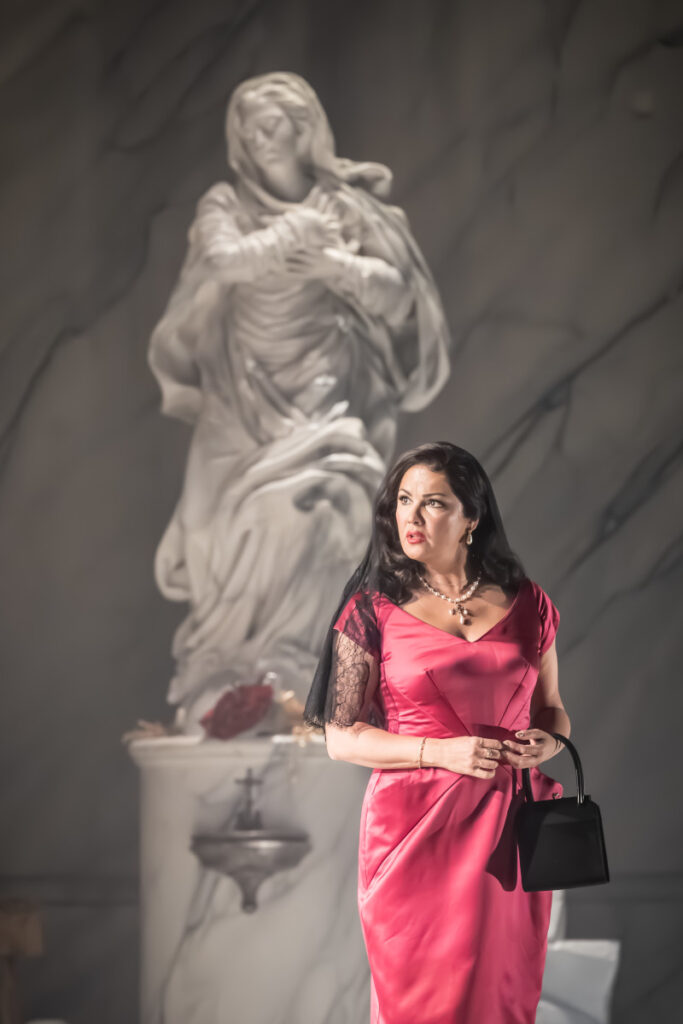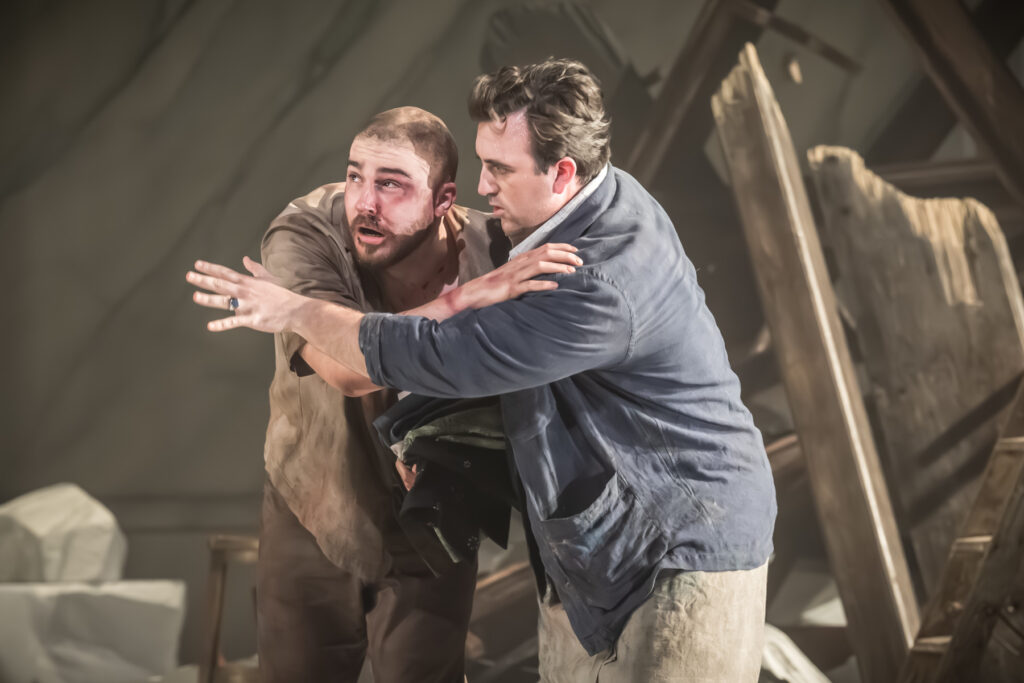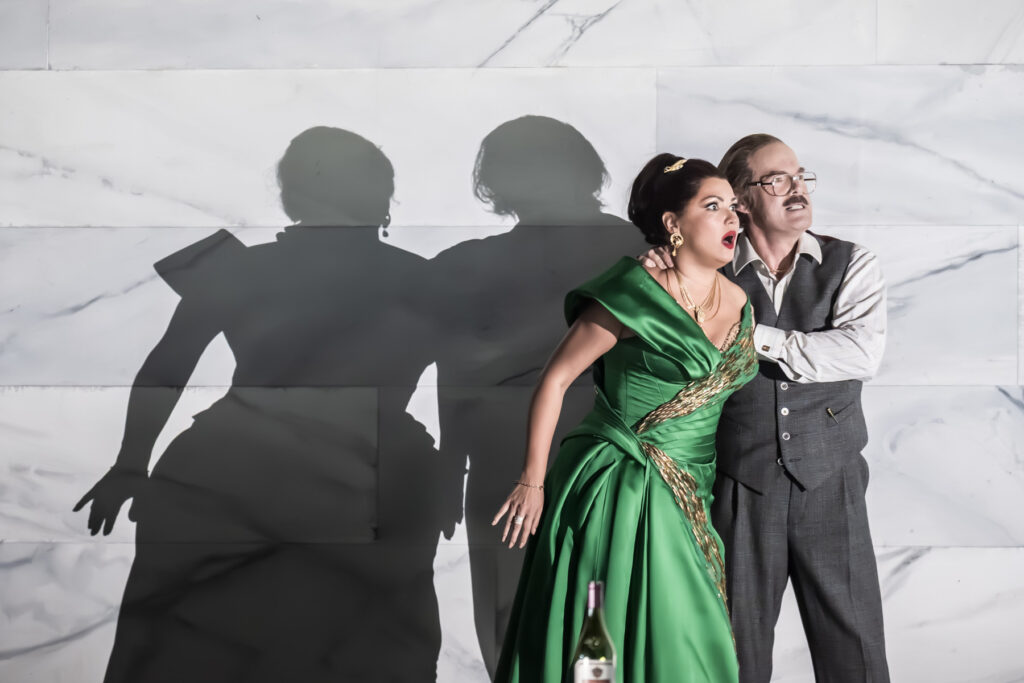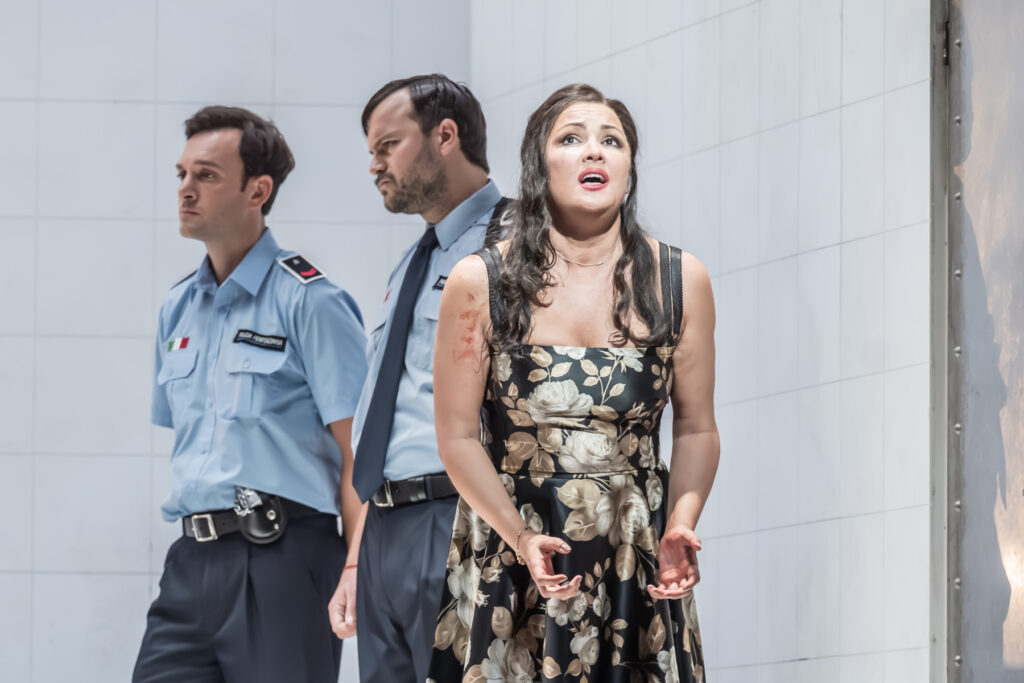After the ‘shabby little shocker’ that was Oliver Mears’s production of Semele, seen at the Royal Opera House just two months ago, he now turns his attention to the opera that first gave rise to that description, Tosca, in this venue’s first new production of it since 2006 to open the new season. If its similarly cinematic range is much less lurid than in the Handel, its sensationalism at least goes more with the grain of an opera set amidst the reign of terror in Napoleonic-era Rome. There are elements of a mindless, violent thriller in the appearances of the torturer, Sciarrone, at the door of Scarpia’s office, followed by the mutilated Cavaradossi in Act Two, and in his graphic, bloody shooting in the next Act, pre-empted by the murder of another political captive.

But it also taps more potently into the theme of certain other films such as La dolce vita in its critical look at how eternal, beautiful Rome is viewed alongside grittier, everyday reality beyond what the epicurean tourist selectively sees. Whereas the Rome of Jonathan Kent’s outgoing production was one of historical realism, here the architectural grandeur of the city’s past is conjured more ironically and distantly. The sequence of physical settings make that point effectively with the sensual marble curves of Act One’s chapel (inspired by Borromini’s architecturally innovative church of Sant’Ivo alla Sapienza, rather than the usual Sant’Andrea della Valle) which gives way to the claustrophobically stark square space of Scarpia’s office – as overwhelmingly monumental and intimidating as Mussolini’s headquarters at the Palazzo Venezia. The prison of Act Three is nothing as sublime or historically resonant as the Castel Sant’Angelo, but an even more closed-in, white-tiled execution chamber. There is no cathartic release into a martyr’s death for Tosca and Cavaradossi on the same reassuring ancient site as generations of earlier heroes, but simply a dehumanising annihilation, clinically administered.

The act of aesthetic consumption as vulgar indulgence is also brought to bear upon Puccini’s score, as well Rome’s built environment. Tosca is put under the glaring spotlight for ‘Vissi d’arte’, the musical highlight that less critically engaged audiences simply wait for before zoning out again, but here it is presented in theatrically ironic quotation marks, as though the object of voyeuristic gaze. Just as Tosca herself is a singer, so some of the other more extended musical passages are delivered by her and the soloists in a rather conservatively static manner so that it seems to be part of a wider strategy to draw attention to the protagonists as characters operating on the stage of Rome.
The war-torn background – shells and rubble falling over the congregation from the roof during Act One’s Te Deum for instance – recreates in general terms the depredations of armed conflict and repression. Setting the drama somewhere around the 1970s precludes identification with any specific battle with which Rome can have been involved, but the avoidance of specific details benefits the production’s sharp focus by not becoming overloaded with exact historical references.

A prominent cast tend to bring a less stereotypically ‘beautiful’ lustre to the work, and so revitalising it. In the title role Anna Netrebko is throaty and moody, her voice sometimes cloaked in a raw veneer and some notes bulge, but still capable of soaring, drawing vociferous approval from the audience. The only protests against the presence of this Putin supporter were, reportedly, outside the Opera House. Freddie De Tommaso’s Cavaradossi is full of passion – fervent in his opening number, vehement and abrupt in his altercations with Scarpia, and unflinching in ‘E lucevan le stelle’. Sometimes there’s an air of a somewhat too self-conscious projection where a little more inwardness would deepen his interpretation, but the even strength of tone up to his upper tenor register is commendable. By contrast Gerald Finley creates a grippingly nuanced Scarpia, stiff and almost inscrutable, but with a sense of frustrated menace in his monologue at the opening of Act Two.
Smaller roles are equally charismatic – Alessandro Corbelli a charmingly fussy, bumbling Sacristan, Ossian Huskinson edgily troubled as Angelotti, on the run as the opera starts, and a snarling, oleaginous Spoletta from Carlo Bosi.

Assuming his role as the new Music Director, Jakub Hrůša conducts a masterful account of that score that has a symphonic trajectory – not just surging and burgeoning in the obvious dramatic moments, but drawing back to allow the vocal passages to come to the fore, so that there is a dynamic interplay between orchestra and stage. He also elicits an array of fascinating timbres from the Royal Opera Orchestra, not for their own sake, but to underline the drama, for instance some brooding Wagnerian sections in the very opening sequence, sombre and well blended woodwind elsewhere, and yearning lower strings immediately before ‘E lucevan le stelle’. The interview with Hrůša in the programme promises the breathing of new life into this ubiquitous opera, and he doesn’t disappoint. A highly auspicious start to his tenure.
Curtis Rogers
Tosca
Composer: Giacomo Puccini
Libretto: Giuseppe Giacosa and Luigi Illica based on the play La Tosca by Victorien Sardou
Cast and Production Staff:
Tosca – Anna Netrebko; Cavaradossi – Freddie De Tommaso; Scarpia – Gerald Finley; Angelotti – Ossian Huskinson; Sacristan – Alessandro Corbelli; Spoletta – Carlo Bosi; Sciarrone – Siphe Kwani; Gaoler – Olle Zetterström; Young Shepherd – Raphy Laming
Director – Oliver Mears; Designer – Simon Lima Holdsworth; Lighting – Fabiana Piccioli; Movement and Intimacy Director – Anna Morrissey; Conductor – Jakub Hrůša; Cardinal Vaughan School and Grey Coat Hospital School Children’s Chorus; Royal Opera Chorus and Orchestra
Royal Opera House, Covent Garden, London, 11 September 2025
All photos courtesy of The Royal Opera © 2025 Marc Brenner